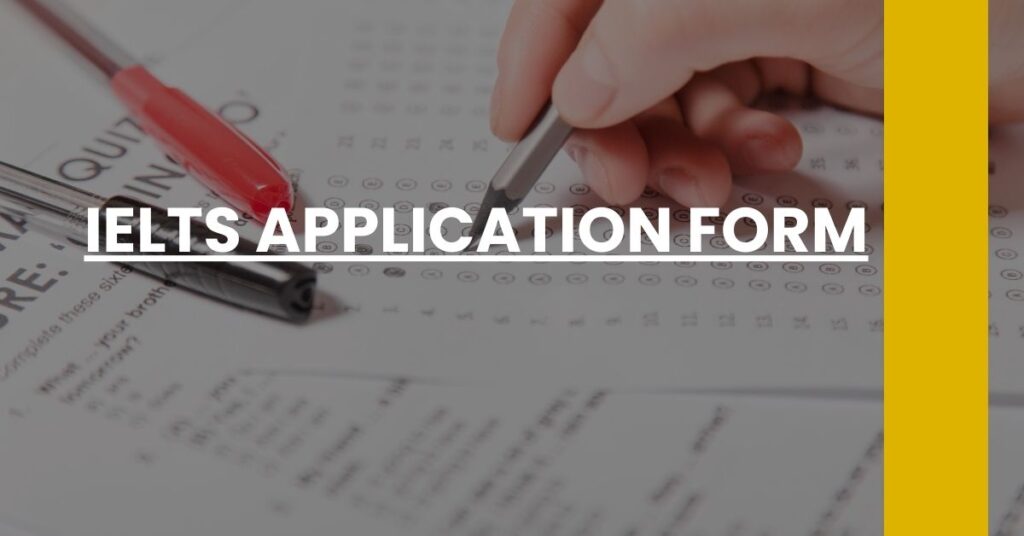Navigating your IELTS application form can set the stage for exam success. Let’s get you started right.
- Simplified Process: Step-by-step guidance ensures your IELTS application goes smoothly.
- Essential Documents: Know exactly what you need to provide for a complete application.
- Expert Advice: Benefit from strategic insights on IELTS test preparation and selection.
Your IELTS application form is the first step to unlocking global opportunities.
- Understanding the IELTS Application Form
- Steps to Register for the IELTS Exam
- IELTS Registration Requirements
- IELTS Fee Structure
- Choosing Your IELTS Test Center
- Preparing for the IELTS Exam: Tips and Resources
- Accommodations for Special Requirements
- After Submission: What to Expect Next
- Rescheduling or Cancelling Your IELTS Test
- Understanding Your IELTS Results
- Frequently Asked Questions About the IELTS Application
- Conclusion: Next Steps After IELTS Application Submission
Understanding the IELTS Application Form
When planning to study, work, or live abroad, showcasing your English proficiency might be on your checklist, and the International English Language Testing System (IELTS) is a widely recognized measure of this. The IELTS application form is your first step towards booking your spot to demonstrate your language skills.
Why is the IELTS Application Form Important?
The IELTS application form is more than just a routine paperwork; it is your entry ticket to international opportunities. It captures all critical information: from your personal details, to your choice of test module, and your selected test center. Every detail on this form is crucial, as inaccuracies can lead to issues down the line, perhaps even in the middle of your Visa application or college enrollment process.
Types of IELTS Tests
You have two primary options for your test type:
- IELTS Academic: For those pursuing higher education or professional registration.
- IELTS General Training: Tailored for those looking at migration opportunities or job prospects.
Each has a different focus, reflecting the sorts of language skills you’re likely to need in academic, or everyday, work and social situations.
Remember, the information you provide in your IELTS application form is also what appears on your Test Report Form, a critical document that universities, employers, and immigration bodies will review closely.
Steps to Register for the IELTS Exam
The step-by-step process ensures a smooth registration journey:
- Choose Your Test Type: Decide between Academic or General Training based on your goals.
- Find a Test Center: Research centers that are convenient, considering location and test dates.
- Check Availability: Ensure your desired test date is available at the chosen center.
- Complete the Online Form: Enter your details accurately, as these will appear on official documents.
- Pay the Test Fee: Secure your spot by completing this final step of the application process.
Ready to get started? Detailed instructions can guide you through each part, ensuring clarity and accuracy—key components that institutions you’re applying to highly value.
IELTS Registration Requirements
Gathering all necessary documents before starting your application can save you time and stress. You’ll need to provide:
- A valid ID: Often your passport or national identity card.
- Personal details: Full name, date of birth, and other demographic information.
- Test choices: Including test type and preferred dates and location.
- Additional information: Such as your native language and any special requirements.
These requirements might seem stringent, but they ensure that on test day, and beyond, your identification and results are undisputed, serving as a reliable testament to your language capabilities.
IELTS Fee Structure
Understanding the financial aspect is crucial; nobody likes surprises in this department. IELTS test fees vary depending on the country and test type. For instance, applicants in India can expect to pay different fees based on the ILTES fee structure set for their location.
Choosing Your IELTS Test Center
While choosing a test center, think convenience and comfort:
- Location proximity: Choose a test center that’s easy for you to get to.
- Test dates: Match your availability with the test center’s schedule.
- Reputation: Consider centers known for excellent candidate support.
For example, choosing the Newark Test Center can be a straightforward decision if you reside in or near New Jersey and wish to take advantage of their reputable services and candidate support.
Preparing for the IELTS Exam: Tips and Resources
Adequate preparation cannot be overemphasized. Here are some tips to ensure you’re fully ready:
- Understand the Format: Familiarize yourself with the test sections – listening, reading, writing, and speaking.
- Practice Persistently: Utilize official practice materials to hone your skills.
- Develop Your Strategies: Learn how to efficiently manage your time during the test.
- Simulate Test Conditions: Try practice tests under timed conditions to get used to the pressure.
Preparing for IELTS doesn’t have to be daunting. There are a plethora of resources to help you, including official IELTS practice books and online resources like British Council’s free practice tests. These are designed to give you an edge by not just exposing you to typical test materials but also by helping you develop strategies to tackle the test confidently.
Accommodations for Special Requirements
If you have specific needs due to physical, medical, or other challenges, the IELTS ensures you can test at your best. Accessibility and fairness are prioritized so that every test-taker has an equitable exam experience.
Identifying Your Needs
Clearly identify your requirements when completing the IELTS application form. Whether you need extra time, adapted materials, or other forms of assistance, specify these needs early in the process. For detailed policies and steps to request special accommodations, the information provided by test administrators can be an invaluable resource.
Submitting the Request
Include any medical certificates or statements from a doctor or educational psychologist to validate your request. It’s crucial to do this well in advance of your test date. The earlier you communicate your needs, the better prepared the test center can be to accommodate you.
After Submission: What to Expect Next
Congratulations! You’ve submitted your IELTS application form. But what happens after you click ‘submit’?
- Confirmation Email: Expect an email confirming your registration along with details about the test location, date, and time.
- Communication: Keep an eye on your email for any communication from the test center. This might include information about test day procedures or reminders.
- Test Day: As you approach the test date, begin final preparations. Review the post-submission instructions to ensure you haven’t missed any crucial steps.
In case you need to contact the test center for any reason, ensure their contact details are handy. It’s all about staying informed and prepared.
Rescheduling or Cancelling Your IELTS Test
Life is unpredictable, and sometimes plans change. If your circumstances alter and you need to reschedule or cancel your IELTS test:
- Notify Promptly: Contact your test center as soon as possible.
- Familiarize with Policies: Each test center may have its own policies regarding timelines and fees for rescheduling or cancelling.
- Keep Records: If you cancel, retain any acknowledgment of cancellation and refund details for your records.
Being aware of the policies can minimize any potential financial or administrative impacts of such changes.
Understanding Your IELTS Results
The culmination of your hard work and meticulous preparation is your IELTS score. Typically, results are released 13 days after the test date.
Receiving Your Results
You’ll receive your results via the method you selected in your IELTS application form. This could be through the mail or by checking online. Your IELTS test center may also provide a service allowing you to receive your results via SMS or email.
Querying Your Score
Should your score not reflect your expectations, you have the option to apply for an Enquiry on Results. This must be done usually within six weeks of the test date. There is a fee for this service, which is refunded if your score is adjusted upwards.
Frequently Asked Questions About the IELTS Application
In the world of IELTS, questions abound; let’s clarify some of the top concerns:
- Can I edit my IELTS application form after submission? Changes to your application details can usually be made by contacting your test center directly.
- Is my personal information secured? Rest assured, IELTS takes privacy seriously, and your personal information is processed in line with applicable data protection regulations.
- Do I need a photograph for my IELTS application? Yes, the application process includes providing a recent photograph that meets certain criteria.
The process can feel intricate, but every question has an answer. Your proactive engagement with FAQs builds confidence and clarity.
Conclusion: Next Steps After IELTS Application Submission
Submitting your IELTS application form marks a significant milestone on your international journey. Remember, the journey doesn’t end with submission. From sharpening your English skills to familiarizing yourself with test day protocols, your active preparation is pivotal. Each step is an investment in a future where language is your asset, not a barrier.
You’re not just preparing for a test; you’re underscoring your ambition with certifiable language expertise that can open doors worldwide. Stay diligent, stay informed, and most importantly, stay focused on the opportunities that await you once you have conquered the IELTS.
Complete your IELTS application form with ease using our step-by-step guide, ensuring a smooth registration for your exam success.

